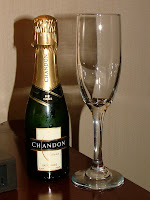It is perhaps the least mellifluous word in the English language, and fares even worse once you know that the term designated the state of the art for guitar strings and surgical sutures for centuries. When you needed to stitch up a wound or play a stringed instrument, your best bet was to use part of the lower GI tract of a farm animal (not cats, but more cattle and sheep and whatnot) and hope for the best. Now there are synthetic substitutes for those products, and you rarely if ever hear someone in the E.R. requesting to be sewn up with traditional catgut.
In the wine industry, the accepted traditional packaging method comes from the 17th century: a glass bottle with a piece of tree bark shoved in it to keep the wine safe and let it breathe and mature over a few years. The problem with natural cork is that there is a high level of variability. Purchase a case of wine, let it rest for five years. Statistically, one bottle will be bad due to cork problems (TCA contamination or oxidation or leakage), and the remaining eleven bottles will vary somewhat depending on how much oxygen has reached the inner contents. Other enclosures have their own problems, as wines can suffer from too much or too little oxygen.
 Nomacorc was founded by a Belgian wine lover named Gert Noël who found such a failure rate of 6-12% unacceptable, and given modern manufacturing standards, it's amazing that the wine business has gone this long with such numbers. He partnered with his son's North Carolina foam manufacturing company (Nomaco) that makes things like pool noodles, and thus Nomacorc was born. As with catgut, perhaps there is a better technology out there, even if it's not the traditional solution.
Nomacorc was founded by a Belgian wine lover named Gert Noël who found such a failure rate of 6-12% unacceptable, and given modern manufacturing standards, it's amazing that the wine business has gone this long with such numbers. He partnered with his son's North Carolina foam manufacturing company (Nomaco) that makes things like pool noodles, and thus Nomacorc was born. As with catgut, perhaps there is a better technology out there, even if it's not the traditional solution. The product has evolved over the years and the company now controls 13% of the world cork market. (Not the synthetic cork market, all cork-shaped enclosures, since most of the other synthetic producers are now gone.) The company has operations in Belgium, Argentina, China, and of course, North Carolina. There are a few standard products, though custom synthetic corks can be produced, and all offer custom printing.
The photo at top depicts the current state of the art product: Select Bio, which is produced from polymers derived from Brazilian sugar cane production. Note the beveled edges, which prevent a "lipping" problem present in early versions of the synthetic cork. Note also that from across a room, you're probably not going to be able to tell that the cork isn't "natural" (even though it's derived from sugar cane).
While the company is the exclusive provider of corks used for Barefoot and Yellowtail still wines sold in the United States, the company is touting its expertise in oxygen transfer management to appeal to the higher end, even collectible market. While at the factory, we got to meet Ben Mayo, the winemaker at Paso Robles' Eberle Winery and an early adopter of the Nomacorc. He said that over the years, he's had no complaints from customers about the switch to synthetic, aside from one fan who had made a trivet from Nomacorcs and was surprised when they melted under a hot casserole dish.
Mayo brought along a bottle of his 2003 Reserve Cabernet Sauvignon, one of the first elite vintages to be enclosed with synthetic corks. This bottle (released at $70, now going for $250), smelled and tasted remarkably young. Full of deep black fruit aromas, touches of leather and cedar, and free of obvious flaws. Not too young, but impressively stable and yet apparent that it will continue to improve over the next 5-10 years. Additionally, the synthetic cork was in great shape. The current batches of Nomacorcs are designed to provide specific oxygenation: different grapes and styles of wine require different rates of oxygen transfer over specific periods of time, and there are tools that the company has developed to find the perfect synthetic cork style for each bottling.
The science behind this whole operation is fascinating, and I'll have more details in my future posts about the winery tour. Stay tuned!
Note: This trip was sponsored by Nomacorc. All opinions are my own.

















































